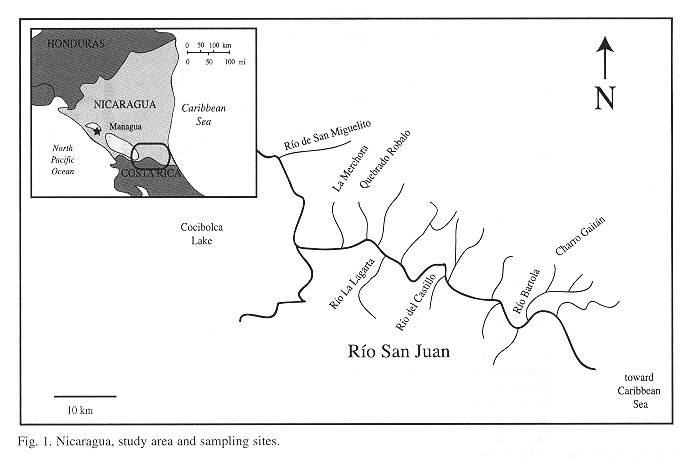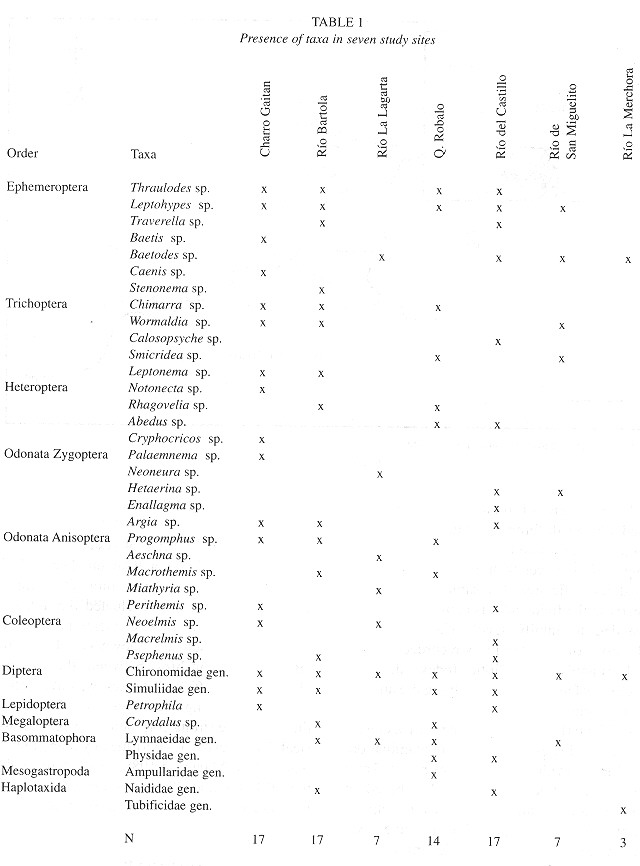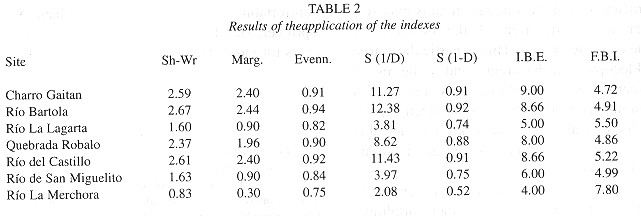Services on Demand
Journal
Article
Indicators
-
 Cited by SciELO
Cited by SciELO -
 Access statistics
Access statistics
Related links
-
 Similars in
SciELO
Similars in
SciELO  uBio
uBio
Share
Revista de Biología Tropical
On-line version ISSN 0034-7744Print version ISSN 0034-7744
Rev. biol. trop vol.50 n.3-4 San José Dec. 2002
Abstract
Biotic indexes are one of severas types of measures that are routinely used in biological monitoring in temperate streams and offer interesting possibilities to assess the environmental quality of rivers in the neotropics. Macroinvertebrate communities of seven southeastern Nicaraguan streams were monitored and seven ecological indexes were applied. The results suggest that information from the Indice Biótico Esteso (I.B.E.) is closely correlated to the results of other methods, but the I.B.E. index is easier to apply as well as avoiding high costs and time-consuming procedures. A calibration of the method is necessary for rapid assessment approaches in the neotropics.
Key words
Benthic macroinvertebrates, biological monitoring, Nicaragua, biotic indexes.
Large and small lowland neotropical streams are being increasingly studied in depth because of their enormous ecological and economic importance (Covich 1988 ). Biological monitoring is an effective tool to assess the ecological quality of a watercourse. Chemical monitoring can also be very important to understand water quality, but it is expensive in terms of equipment and time and often offers only limited information. Furthermore, biological monitoring can give an indication of past as well as present conditions. Biological methods offer interesting possibilities of application in neotropical lotic environments: here they allow overcome the logistic difficulties of traditional chemical-physical surveys and appear advantageous from an economic point of view, thus providing synthetic information in a short time. In some countries, such as Honduras and Costa Rica, there is an increasing interest in the use of bioindicators. Some studies have used diatoms as bioindicators (Michels 1998 ). However, there are some difficulties in diatom identification and complex technical equipment and highly specialised knowledge are needed. The use of the so-called benthic macroinvertebrates appears more advantageous, and consolidated (Hellawell 1986 ), partly because the taxonomic and autoecological knowledge of these organisms today is better than other aquatic groups, such as algae or mesofauna ( Jackson and Sweeney 1995 ). Moreover, their sensitivity varies according to numerous environmental factors, both biotic and abiotic. Consequently, their community structure has often been used as an indicator of the general conditions of a river's aquatic environment. Knowledge about the benthic macroinvertebrates of Central America is making rapid progress (Hurlbert and Figueroa 1982 , Roldán 1988 , Fernández and Domínguez 2001 ). Nevertheless, the analysis used so far in Central America has not always been appropriate in representing the environmental situation; in some cases the evaluation of river quality was drawn from the application of 'classical' ecological diversity indexes, i.e. Shannon-Wiener (Krebs 1985 ) and Simpson (Simpson 1949 ). In other cases, biotic indexes formulated for North American rivers (Biotic Index-Hilsenhoff 1987 , Family Biotic Index-Hilsenhoff 1988 ) were used. All these methods require quantitative sampling; moreover, the Hilsenhoff's indexes give great importance to some systematic groups (i.e. insects) and are focused on alterations caused by organic pollution.
In Costa Rican streams, aquatic entomofauna (Springer 1998 ) and macroinvertebrate community structures (Ramírez and Pringle 1998 ) were recently investigated. Furthermore, comparisons between disturbed and undisturbed sites and between sampling methods were made, using a species diversity index (Paaby et al. 1998 ). In Nicaragua, except for some studies on aquatic insects ( Maes 1988 , 1989a , 1989b , 1995 , 1998 , Maes et al. 1988 , Maes and Flint 1988 , Fenoglio 1999 ), benthic macroinvertebrate fauna is poorly known. Recently, application of diversity indexes to the macroinvertebrate communities has begun (García pers. comm.) The aim of our study was to test some biotic and ecological indexes in Nicaraguan rivers and to compare their relative effectiveness and ease of their use.
Study area: The study area is the Río San Juan hydrographic network (Fig. 1 ), characterized by a humid tropical climate and intense precipitations from May to January. The air temperature varies around the year from a minimum of 23ºC to a maximum of 36.6ºC. Human activities and urban settings decrease conspicuously going from Lake Cocibolca towards the sea. San Carlos and San Miguelito have the greatest urban extension of the whole area, where, besides the activity of tradicional fishing, extensive agriculture is practised. In the few last years cattle breeding has increased in large deforested areas. Further along the valley, uncultivated areas and secondary forests increase, until Refugio Bartola and Gran Reserva Indio-Maiz, which are protected primary forests. In the seven sites studied in the Río San Juan district very different environmental situations were noticed. In some of them (Charro Gaitan, Río Bartola and Río del Castillo) the river goes through primary or secondary forest and no traces of alteration of anthropic origin were noticed. In other study sites, there are small urban agglomerations and cultivations. Río La Merchora receives sewage directly from a village and organic material from a small fish processing firm: the presence of evident colonies of filamentous bacteria and a diffused anaerobic patina below the submerged material immediately testifies the high degree of environmental alteration of this site.

Materials and methods
Our data was collected in southeastern Nicaragua during two periods (October November 1998 and October 1999), in cooperation with the Universidad Popular de Nicaragua - San Carlos. Seven sites exposed to various anthropic impacts were examined along the tributarios of Río San Juan (Fig. 1 ). Benthic macroinvertebrates were sampled using a dip-in net (250 pm mesh) according to the quantitative method describes by Hilsenhoff (1987) . Samples were fixed in ethanol 70' and subsequently examined in the laboratory with a compound scope (20/60 X). Taxonomic identification of organisms was perfonned using the following texts: Roldan Peréz (1988) , Merritt and Cummins (1996) , Wills Flowers (1992) , Springer et al. (in prep.).
Ecological indexes: Benthic communities were analyzed by the application of seven ecological indexes: Shannon - Weaver (Krebs 1985 ), Simpson (I-D and I/D) (Simpson 1949 ), Evenness (Pielou 1969 ), Margalef (Clifford and Stephenson 1975 ), Family Biotic Index (Hilsenhoff 1988 ), Indice Biotico Esteso (Ghetti 1997 ).
Shannon-Wiener, Margalef, Simpson and Evenness are "classical ecological indexes", created to measure diversity in ecological communities. The Family level Biotic Index ( Hilsenhoff 1988 ) is a synthetic index used in field assessment of organic pollution. It is based on the different tolerance of different families of arthropods. The metbod needs a sample of no fewer than 100 arthropods collected in a riffle area. The sample is examined directly in the field and it is then separated and classified to family level. The number of arthropods of each family is recorded and the EB.I. (Family-level Biotic Index) index is therefore calculated by multiplying the number of specimens of every family by its tolerance value. The EB.I. can vary from 0 to 10, detecting seven classes of organic contamination. The I.B.E. method derives from the Trent Biotic Index ( Woodiwiss 1964 ). It is based on two evaluation parameters: taxonomic richness and the presence of pollution-sensitive taxa. This method offers synthetic information about the general conditions of river ecosystems, underlining potential alterations. This method is widely used in Italy to assess the state of health of rivers, and its application is envisaged by Italian legislation (Decree Law 152/99).
Results
Altogether, 38 different systematic unities were determined, for a total number of 702 individuals ( Table 1 ). The community composition at each site was evaluated through the application of the above mentioned seven indexes. The results are shown in Table 2 . To test the relationships between the results obtained with different indexes, we ran a statistical analysis using Spearman's correlation test ( Table 3 ). The strong correlation between 'classical' index results is confirmed by many previous studies (Magurran 1988), and interestingly the I.B.E. method also shows a significant correspondence with other monitoring tools.



Discussion
We found an evident correspondence between I.B.E. values and the environmental situation at each site. According to its fauna, the most contaminated site was Río La Merchora, in which we found only three taxa, while Río Bartola, Río El Castillo and Charro Gaitan were the sites with the greater diversity of benthic macroinvertebrates.
Comparison between indexes: The application of seven different ecological indexes underlined that the I.B.E. index offers results which are well correlated with those obtained with other indexes. The I.B.E. is equally effective if it is compared with the other indexes from the diagnostic point of view, and it seems quicker and more versatile in this context. In fact, I.B.E. does not require quantitative sampling (as the indexes of difference do) or a deep knowledge of the ecological characteristics of all the taxa (required in the case of the EB.I.). Furthermore, I.B.E. offers a general picture of the environmental situation by combining indications about the taxonomic richness with information on the sensitivity of the different taxa. I.B.E. considers the benthic macroinvertebrate's community and not only arthropods and a few other groups as the Hilsenhoff index does, in its original layout (Hilsenhoff 1987 , 1988 ) and in its following modifications (Resh et al. 1996 ).
Problems and preliminary hypothesis of I.B.E. setting for its use in the neotropics: Direct application of the method can be problematic, especially because of the limited knowledge of biocenosis at taxonomic and ecological-functional levels.
For this purpose, we can hypothesize two phases. First, knowledge related to other fauna can be deductively employed. In fact, the high taxonomic groups are very similar to their European and North American relatives, which are already well known. In 1874, Thomas Belt wrote in 'The naturalist in Nicaragua': "All the land fauna was strikingly different from that of other regions; but the water fauna was as strikingly similar", and moreover "The close affinities of fresh-water animals and plants have been noticed by many naturalists", an element also verified in our samplings. In the near future, information related to the local fauna will be available and could he employed: for example, the University of Costa Rica is preparing a key for benthic macroinvertebrates (Springer et al. in prep.). When this tool is available, it could be applied to numerous Central American situations, including Nicaragua.
A calibration of the I.B.E. index must be made for its correct application in the neotropics:
Exclusion or diminution of the relative importance of some groups. The environmental characteristics of Nicaraguan streams impose a different consideration of the bioindicator value of some groups. This is particularly true for Plecoptera: in Nicaragua and in the rest of southem Central America only one genus (Anacroneuria sp., Perlidae) has been reported. Its distribution is less known but this species seems extremely located in Nicaragua (Stark 1998 ).
Inclusion of other macroinvertebrate groups. During this study and other samplings, (Fenoglio 1999 ) we have often recovered specimens belonging to taxonomic groups of remarkable local numerical and ecological importance that we have not considered in the calculation of the I.B.E., because they do not have not vicariant species in European streams. We can report Lepidoptera Pyralidae of the genus Petrophyla and Hemiptera Belostomatidae of the genus Abedus, Belostoma and Lethocerus. From direct observations and bibliographical indications (Springer 1998 ) nymphs of the genus Epilampra (Blattodea, Blaberidae) should also be included. Moreover, considering the fauna composition of the Nicaragua river, it is also advisable to use all the species of Anisoptera and Zygoptera (Odonata) for the calculation of the I.B.E.
Further validation of the proposed methodology will include the comparison between abiotic conditions of streams. Calibrating the method to the specific environmental situation would allow the diffusion of this biomonitoring tool in the Central American area.
An adaptation of I.B.E. could represent a rapid and cost-effective assessment instrument: I.B.E. could be employed routinely in large monitoring plans, while a quantitative ap proach lo community-level analysis could be used only in cases of particular interest.
Acknowledgements
We thank U.PO.NIC. - San Carlos who provided the local facilities and made our work comfortable. We also thank J.M. Maes, M. Springer, Merida, S.A. and two anonymous referees for valuable suggestions and comments.
Resumen
Los índices bióticos representan una topología de medidas que se emplea rutinariamente en el control biológico de los ambientes lóticos templados: ellos ofrecen también interesantes posibilidades en el área neotropical. Para evaluar la calidad ambiental de algunos ríos de Nicaragua, investigamos las comunidades macrobentónicas y aplicamos siete índices ecológicos. Los resultados sugieren que el índice I.B.E. se relaciona fuertemente a los otros índices, pero permite ahorrar costos y tiempo. Una calibración del método sería necesaria para obtener un método de valoración rápida de la calidad ambiental de los ríos de Centro América.
References
Belt, T. 1874. The naturalist in Nicaragua. Chicago Univ., Chicago. [ Links ]
Clifford, H.T. & W. Stephenson. 1975. An introduction to numerical classification. Academic, London. [ Links ]
Covich, A.R 1988. Geographical and historical comparisons of neotropical streams: biotic. diversity and detrital processing in highly variable habitats. J. N. Am. Benthol. Soc. 7: 361-386. [ Links ]
Fenoglio, S. 1999. Entomofauna acuática de ambientes lóticos: observaciones ecológicas en el Refugio Bartola y nuevos taxa para Nicaragua. Rev. Nica. Ent. 4: 29-43. [ Links ]
Fernández, H.R. & E. Domínguez (eds.). 2001. Guía para la determinación de los artrópodos bentónicos sudamericanos. UNT, Tucuman. [ Links ]
Ghetti, RE 1997. Manuale di applicazione Indice Biotico Esteso (I.B.E.) Prov. Aut. Trento, Trento. 222 p. [ Links ]
Hellawell, J.M. 1986. Biological indicators of freshwater pollution and environmental management. Elsevier, New York. 546 p. [ Links ]
Hilsenhoff, W.L. 1987. An improved biotic index of organic stream pollution. Great Lakes Entomologist 20: 31-39. [ Links ]
Hilsenhoff, W.L. 1988. Rapid field assessment of organic pollution with a family-level biotic index. J. N. Am. Benthol. Soc. 7: 65-68. [ Links ]
Hurlbert, S.H. & A.Y Figueroa (eds.). 1982. Aquatic Biota of Mexico, Central America and the West Indies. San Diego State Univ., San Diego. [ Links ]
Jackson, J.K. & B.W. Sweeney. 1995. Research in tropical streams and rivers: introduction to a series of papers. J. N. Am. Benthol. Soc. 14: 2-4. [ Links ]
Krebs, C.J. 1985. Ecology: the experimental analysis of distribution and abundance. Harper & Row, New York. [ Links ]
Maes, J.M. 1988. Catálogo de los Ephemeroptera y Plecoptera de Nicaragua. Rev. Nica. Ent. 2: 49-50. [ Links ]
Maes, J.M. 1989a. Catálogo de los insectos consoladores biólogicos en Nicaragua. Vol. I. Insectos depredadores (primera parte). Rev. Nica. Ent. 4: 2943. [ Links ]
Maes, J.M. 1989b. Catálogo de los insectos consoladores biólogicos en Nicaragua. Volumen II. Insectos depredadores (segunda parte). Rev. Nica. Ent. 9 : 1120- [ Links ]
Maes, J.M. 1995. Haliplidae, Ciidae y Sphindidae (Coleoptera). Tres familias nuevas para la fauna de Nicaragua. Rev. Nica. Ent. 32:1-3. [ Links ]
Maes, J.M., J.P. Desmedt & Y Hellebuyck. 1988. Catálogo de los Odonata de Nicaragua. Rev. Nica. Ent. 4: 2943. [ Links ]
Maes, J.M. & O.S. Flint. 1988. Catalogo de los Trichoptera de Nicaragua. Rev. Nica. Ent. 2: 1 -11. [ Links ]
Maes, J.M. 1998, Insectos de Nicaragua. Vol. 1, Print-León, Nicaragua. [ Links ]
Magurran, A.E. 1988. Ecological diversity and its measurement. Cambridge University, Cambridge. [ Links ]
Merritt, R.W. & K.W. Cummins (eds.). 1996. An introduction to the aquatic insects of North America. Kendall/Hunt. Dubuque, 10. [ Links ]
Michels, A. 1998. Use of diatoms for water quality assessment in two tropical streams in Costa Rica. Rev. Biol. Trop. 46: 143-153. [ Links ]
Paaby P., A. Ramírez & C.M. Pringle. 1998. The benthic macroinvertebrate community in Caribbean Costa Rican streams and the effect of two sampling methods. Rev. Biol. Tro . 46: 185-199. [ Links ]
Pielou, E.C. 1969. An introduction to mathematic ecology. Wiley, New York. 286 p. [ Links ]
Ramírez, A. & C.M. Pringle. 1998. Structure and production of a benthic insect assemblage in a neotropical stream. J. N. Am. Benthol. Soc. 17: 443-463. [ Links ]
Resh, VH., Myers M.J. & M.J. Hannaford. 1996. Macroinvertebates as biotic indicators of environmental quality. pp. 647-668. In ER. Hauer. & G.A. Lamberti (eds.). 1996. Methods in Stream Ecology. Academic, San Diego, CA. [ Links ]
Roldán, G. 1988. Guía para el estudio de los maeroinvertebrados acuáticos del Departamento de Antioquia. Universidad de Antioquia-CIEN, Antioquia, Colombia. [ Links ]
Simpson, E.H. 1949. Measurement of diversity. Nature 163: 688. [ Links ]
Springer, M. 1998. Genera of aquatie insects from Costa Rica, depositad at the Museo de Zoologia, Universidad de Costa Rica. Rev. Biol. Trop. 46: 137-142. [ Links ]
Stark, B.P. 1998. The Anacroneuria of Costa Rica and Panamá (Insecta: Plecoptera: Perlidae). Proc. Biol. Soc. Washington 111: 551-603. [ Links ]
Wills Flowers, R. 1992. Review of the genera of Mayflies of Panama, with a Checklist of Panamanian and Costa Rican Species (Ephemeroptera) pp. 37-51. In D. Quintero & A. Aiello (eds.). Insects of Panama and Mesoamerica, Oxford University, Oxford. [ Links ]
Woodiwiss, F.S. 1964. The biological system of stream classification used by the Trent River Board. Chem. Ind. 14: 443-447. [ Links ]
1 Di.S.T.A., Univ. del Piemonte Orientale - Via Cavour 84 I-15100. Alessandria, Italia.
2 Univ. di Torino - Dip. di Biologia Animale e dell'Uomo, Via Ace. Albertina 17. Torino, Italia fenoglio@mfn.unipmn.it














